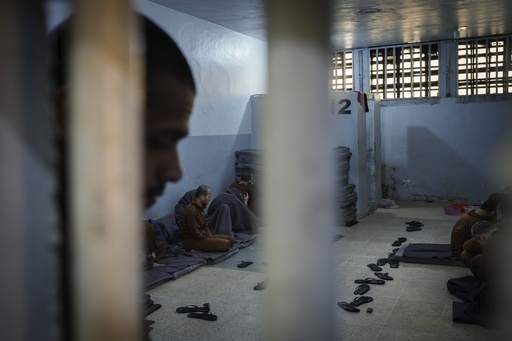HASSAKEH, Syria — In a grim setting, men of different ages and from various national backgrounds sit quietly in their prison cells, where their only connection to the outside world comes from a small window in the metal doors. These individuals are believed to be associated with the Islamic State group, apprehended during the final stages of the extremist group’s self-declared caliphate, which once spanned significant parts of Iraq and Syria.
Approximately 4,500 detainees have been held at the facility known as Gweiran Prison, recently renamed Panorama. An exclusive visit revealed this situation nearly two months after the dramatic ousting of President Bashar Assad in Syria — a major political shift that many detainees may remain unaware of, as prison officials strive to restrict outside information from reaching them.
The faltering of the Assad regime in December following a swift insurgent offensive has drawn renewed scrutiny and heightened pressure on detention centers in northeastern Syria, which currently holds around 9,000 IS affiliates without facing trial.
These facilities are overseen by members of the Syrian Democratic Forces (SDF), who are supported by the United States. The SDF achieved a significant milestone in March 2019 when they seized the last territory occupied by IS in the eastern town of Baghouz.
According to SDF Chief Commander Mazloum Abdi, following the demise of Assad, IS members managed to capture large caches of weapons in eastern Syria from abandoned positions previously held by loyalist forces to the former president. An anonymous SDF security official cautioned that there is a risk of extremist assaults on detention centers aimed at liberating fellow militants.
“The detainees are akin to a literal and figurative ‘ISIS army’ in detention,” stated General Michael Erik Kurilla, commander of the U.S. Central Command, during a recent visit to Syria.
The prison tour was conducted in a corridor lined with six cells on each side, where masked guards were positioned with clubs. When a window in one cell door was opened, detainees were allowed a brief exchange with journalists. One of the detainees, a young man named Maher, identified himself as a nurse from Melbourne, Australia. As per prison regulations, only first names were permitted.
Expressing a desire to return to Australia, Maher mentioned that he had voluntarily surrendered when the U.S.-led coalition announced a humanitarian corridor, not being captured during the seizure of Baghouz in 2019. “I haven’t harmed anyone. I’ve been here for seven years without any legal proceedings,” he lamented, voicing remorse for numerous past actions.
Maher also shared that he is married to a Syrian woman and has two sons, currently residing in a camp for families associated with IS members in northeastern Syria. He conveyed concern over not receiving updates about them, revealing that he had sent a letter to his parents through the International Committee of the Red Cross but never got a reply.
The security of these detention centers is increasingly under scrutiny following the fall of Assad. A notable incident occurred in January 2022 when IS militants attacked one of the prisons, which led to ten days of violent clashes with the SDF, resulting in nearly 500 fatalities.
Originally part of a technical school, the prison has since undergone renovations with assistance from the U.S.-led coalition. During the recent media visit, security measures were stringent, with armed personnel stationed along roads leading to the facility. However, SDF leaders have expressed that ongoing clashes between their fighters and Turkish-backed forces in northern Syria, coinciding with the insurgent offensive that precipitated Assad’s downfall, pose challenges to maintaining safety at the prisons.
In a recent meeting with Turkey’s foreign minister, Syria’s Asaad al-Shibani revealed Ankara’s willingness to assist Syrian authorities in overseeing the detention centers and the camps holding over 40,000 individuals, many of whom are women and children with suspected IS ties. Nonetheless, the SDF commander dismissed the notion, asserting that Turkey’s assistance should instead focus on ceasing its attacks, allowing them to ensure the security of facilities like al-Hol and the prisons.
He added that management of such facilities should be handled internally within Syria, mentioning ongoing discussions between the SDF — which governs nearly a quarter of Syrian territory — and the newly established government in Damascus backed by the Hayat Tahrir al-Sham group.
Inside the prison, detainees remain in limbo awaiting news on their fates. A British prisoner, preferring to remain unnamed, articulated his wish to return to the UK and face trial there. He recounted how, as an 18-year-old, he first came to Syria about a decade ago, initially motivated by media reports about the atrocities committed by Assad’s government forces against children during a popular uprising that devolved into civil war. He expressed regret over becoming trapped in IS, stating, “Once you enter (IS), it’s challenging to exit.”
Claiming he had never fought but merely bought and sold cars while in IS-controlled territories, he asserted that all men captured by the SDF in Baghouz in early 2019 were categorized as IS affiliates. With seven years behind bars, he expressed, “To survive a day in this place is a miracle,” indicating that neither he nor his fellow prisoners maintain knowledge of current events, not even the date. When quizzed about the day, he responded, “We are in early 2025.”



